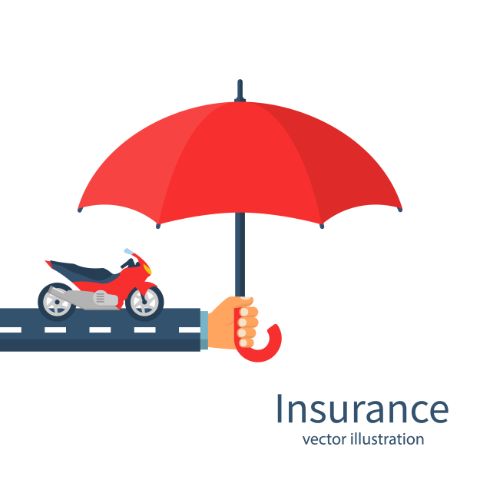Quick Tips to Control Your Bike after a Tyre Burst
Quick Tips to Control Your Bike after a Tyre Burst

As our roadways get better, and our motorcycles go faster, there are increasing incidents of tyre blowouts that cause loss of balance and some serious accidents. However, if you do understand how to control a bike in these scenarios, a tyre blowout does not have to be catastrophic.
The most common error individuals make, other than not staying protected by comprehensive bike insurance, is to apply the brakes as soon as a tyre explodes. That is the deadliest move you can do since it results in total loss of balance, and in extreme circumstances, the rapid tug to one side caused by a burst tyre could be so intense that the vehicle spins or flips over.
So, how can you operate a motorcycle if a tyre blows out unexpectedly?
1. Do not press the brakes right away!
True, our minds are hardwired to press the brakes immediately if something goes awry, but this isn't a general norm. If you're going above 50 km per hour and a tyre blows out, don't press the brakes right away; instead, attempt to roll the motorcycle without using the brakes. The explanation behind this is that the very crucial thing to do at that pace is trying not to lose control over the bike. Pressing the brakes will cause the motorcycle to wobble and thus, chances are you will lose your balance and you drop from the seat. So, under this circumstance, never press the brakes!
2. Go slow
A blowout or flat tyre is probably the most common motorcycle accident these days. While there might be numerous reasons for a blowout, it is mostly identified as the broken or damaged tyre that led to the accident. The most important thing to do in order to escape from this type of accident is to avoid braking and avoiding spontaneous turns as they both would cause uneasiness and imbalance in the bike. Of course, depending on the scenario, you will need to turn the motorcycle and escape the danger area but aim to do so in a linear manner rather than a sharp turn, because a blown tyre will significantly unbalance the motorcycle, and if you undertake a rapid turn, expect major consequences.
3. Utilize engine braking
If you're riding a motorcycle with strong engine braking, you may carefully slow down the pace by changing the gears and using the engine braking rather than applying the brakes. As there will be no abrupt force from the brakes, this is the safest approach to reduce speed and will not cause your bike to tremble. The safest approach to avoid a tyre burst is to monitor your tyre pressure on a regular basis. Check the state of your tyres every week to ensure there is no sidewall crack, bulge, or bald place that might cause problems during a high-speed drive. When you travel, particularly on concrete roadways, the heat in the tyre raises its pressure, and every weak place on the rubber is a possible blowout location.
We frequently fail to inspect the tyres. Tyres are improving with time as technology advances, and new solutions to make driving more comfortable are being developed. Some of us believe that biking with fewer treads won't make a difference, but it will if you're on the highway. However, it is always a good idea to check the condition of your tyres on a weekly basis. Remember that reduced tread means it's time to change the tubes, so be cautious of your every move when driving. It is also critical to have a financial safety net in place in the event of a tyre burst. Under a comprehensive bike insurance package, you can obtain cashless services at any network garage following an accident.
Conclusion
This all sounds so simple, but there are so many things, small and large, that can go wrong when driving. To help prevent that from happening, all vehicles need to be in good shape and in proper working order. And if you do come across an issue with your vehicle, don’t hesitate – get it fixed before the problem leads to a bigger issue further down the line. A comprehensive bike insurance policy will aid you with anything from legal third-party obligations and damage to your two-wheeled beauty to emergency roadside assistance in the event of a tyre burst accident. It is strongly advised that you buy bike insurance for your two-wheeler. After putting this guide together for you, we hope you’ll be ready and willing to hit the road in no time. Good luck out there, and remember to ride safe!
Disclaimer: The above information is for illustrative purpose only. For more details, please refer to policy wordings and prospectus before concluding the sales.
RELATED ARTICLES
Here’s why comprehensive bike insurance is a better bet than third-party insurance
Why Buy A Comprehensive Two Wheeler Insurance for your Scooter
Benefits of Comprehensive Two-Wheeler Insurance










 Health Insurance
Health Insurance  Travel Insurance
Travel Insurance  Car Insurance
Car Insurance  Cyber Insurance
Cyber Insurance  Critical Illness Insurance
Critical Illness Insurance
 Pet Insurance
Pet Insurance
 Bike/Two Wheeler Insurance
Bike/Two Wheeler Insurance  Home Insurance
Home Insurance  Third Party Vehicle Ins.
Third Party Vehicle Ins.  Tractor Insurance
Tractor Insurance  Goods Carrying Vehicle Ins.
Goods Carrying Vehicle Ins.  Passenger Carrying Vehicle Ins.
Passenger Carrying Vehicle Ins.  Compulsory Personal Accident Insurance
Compulsory Personal Accident Insurance  Travel Insurance
Travel Insurance  Rural
Rural 











